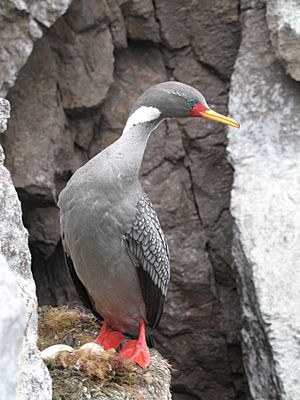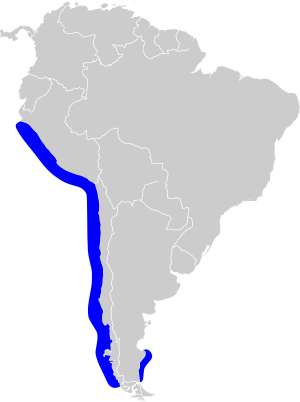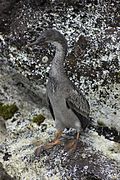Red-legged cormorant facts for kids
Quick facts for kids Red-legged cormorant |
|
|---|---|
 |
|
| Conservation status | |
| Scientific classification | |
| Genus: |
Poikilocarbo
|
| Species: |
gaimardi
|
 |
|
The red-legged cormorant (Poikilocarbo gaimardi) is a special type of cormorant. It lives along the coasts of South America. People also call it the red-legged shag or grey cormorant. This bird is the only one in its group, called Poikilocarbo.
Unlike most seabirds, red-legged cormorants do not live in big groups. They usually live alone or in small pairs. Also, they do not spread their wings to dry them, which is unusual for cormorants.
Contents
About the Red-Legged Cormorant's Name
Scientists group living things into categories. This is called Taxonomy. The red-legged cormorant was first placed in a group called Phalacrocorax.
However, studies showed it was more closely related to other cormorants from the southern part of the world. So, in 2014, scientists moved it to its own group, Poikilocarbo. The IOC agreed with this change in 2021.
Some scientists think the red-legged cormorants living on the Atlantic coast might be a slightly different type. They are a bit smaller and lighter in color than those on the Pacific coast. Scientists believe this bird group started to become different from other cormorants about 12 to 13.5 million years ago.
What Does the Red-Legged Cormorant Look Like?
The red-legged cormorant is a medium-sized seabird. It has a long neck, a smooth body, and webbed feet. Its bill is long, thin, and hooked. These birds are about 71 to 76 centimeters (about 28 to 30 inches) long. Their wings can spread up to 91 centimeters (about 36 inches). They weigh about 1.3 to 1.5 kilograms (about 3 pounds). Male and female birds look the same.
It is easy to spot a red-legged cormorant. Adult birds have a smoky grey body. Their belly is a bit lighter. They have small white feathers behind their eyes and on their neck. Their wing feathers look silvery grey with wide black tips. The tail is also black.
Their eyes are green with tiny blue marks around them. The bill is yellow, turning orange near the head. The skin under their chin, called the gular skin, is bright orange or red. Their legs and feet are a bright coral red.
When adults are not breeding, they look similar. But they do not have the white feathers. Their wings look darker grey, and their bill and chin skin are not as bright.
Young red-legged cormorants are usually paler and brown. They have some white spots around their throat. Their eye color is grey. Their bills and chin skin can be black or orange. Their legs and feet can be dull orange or reddish-black.
Where Do Red-Legged Cormorants Live?
The red-legged cormorant lives along the coast of South America. On the Pacific side, they are found from Peru down to Chile. On the Atlantic side, there are small groups in Santa Cruz, Argentina. They rarely go further south than the Strait of Magellan.
These cormorants build their nests on steep rock faces. This includes coastal cliffs, rocky islets (small islands), and sea caves. Their speckled grey feathers help them blend in with the rocks. Only their colorful bills and feet stand out. They look for food in shallow waters close to the shore.
Red-Legged Cormorant Behaviour
Reproduction and Life Cycle
The red-legged cormorant does not live in large groups like many other seabirds. Instead, they live in pairs or small family groups. They usually start looking for a mate in January and February.
Male birds perform special dances to attract females. They might dart their heads back and forth while chirping softly. They also show the inside of their mouth. If a female comes closer, the male will stretch his neck and point his bill towards his tail. The female might hop and make clicking sounds with her throat.
Once a female chooses a male, they will preen each other's feathers. Red-legged cormorant pairs often stay together for at least one breeding season.
They build their nests on steep cliffs. These nests are usually far from other birds. But sometimes, small groups of nests can form. Nests are made from feathers, bird droppings (guano), seaweed, and even trash. They have been seen diving 8 to 10 meters (about 26 to 33 feet) deep to collect nesting materials.
Females lay eggs between October and January. They usually lay about three eggs. The eggs hatch after about 30 days. When the chicks are born, they have no feathers. But they quickly grow soft, brownish down. Like all cormorant chicks, they need their parents to feed and care for them. The chicks stay in the nest for 60 to 70 days.
How They Find Food
Red-legged cormorants usually look for food alone. But sometimes, they hunt in pairs or small groups. Most of them do not go further than 3 kilometers (about 2 miles) from their nest to find food.
They hunt in shallow waters near the coast, including estuaries (where rivers meet the sea). They never go into fresh water. Many red-legged cormorants hunt when the tide is low. This might be because it is easier to dive and find food then. They can dive 8 to 10 meters (about 26 to 33 feet) deep to catch their prey. Their diet mainly includes fish, like eels and anchovies, and small sea creatures called planktonic crustaceans.
Voice
The calls of red-legged cormorants are different from most seabirds. They make high-pitched chirps and chirrups. These sounds are more like a songbird than a typical seabird.
Status and Conservation
The red-legged cormorant is listed as "Near Threatened" by the IUCN Red List of Threatened Species. This means their numbers are decreasing, and they might become endangered if we don't protect them.
Predators
These birds build their nests on steep cliffs. This makes it hard for most predators to reach them. Their main natural predators are kelp gulls. Humans also hunt adult birds, chicks, and eggs.
When a red-legged cormorant feels threatened, it does not have a strong way to scare off enemies. It might just open its mouth and point its bill at the intruder. This might be because they live alone and do not have many natural predators.
See also
 In Spanish: Cormorán gris para niños
In Spanish: Cormorán gris para niños




